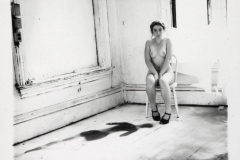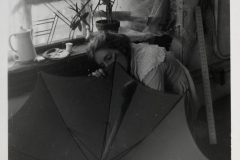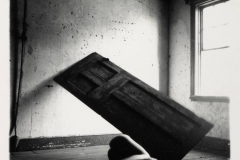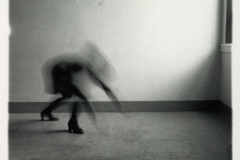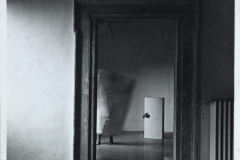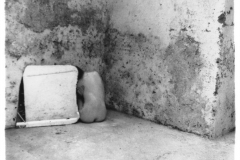Research Task: Francesca Woodman
“It is difficult not to read Woodman’s many self-portraits – she produced over five hundred during her short lifetime – as alluding to a troubled state of mind. She committed suicide at the age of twenty-two.”
Look up the work of photographer Francesca Woodman online.
What evidence can you find for Bright’s analysis?
Francesca Woodman (1958-1971) was an American photographer best known for her black and white self-portraits where she often posed nude, sometimes partly hidden, and employed slow exposures that resulted in blurred images that suggested her presence and gave them a sense of surrealism. She came from a creative family, her father was a painter and photography lecturer at the University of Boulder in Colorado, while her mother was a ceramicist and sculptor. She attended the Rhode Island School of Design.
Looking at Woodmann’s images and researching her background, I feel one has to be careful reading them as alluding to a troubled state of mind and letting her suicide be a context or pre-text for everything she did. It’s important to recognise and acknowledge that many people who suffer from mental health issues don’t always do so continuously and it doesn’t have to define everything they do or don’t do. They have good and bad days and many in-between.
In an interview in the Guardian with Rachel Cooke (https://www.theguardian.com/artanddesign/2014/aug/31/searching-for-the-real-francesca-woodman accessed 04/04/2022) her mother Betty explains,
“Her life wasn’t a series of miseries. She was fun to be with. It’s a basic fallacy that her death is what she was all about, and people read that into the photographs. They psychoanalyse them. Young people in particular feel she’s talking about them, somehow. They see the photographs as very personal. But that’s not the way I approach them. They’re often funny.”
Bright’s analysis that Woodman’s self-portraits allude to or are a reflection of a troubled state of mind doesn’t do the work full justice, and in light of Woodman’s suicide is a somewhat obvious and one-dimensional analysis-its all too easy to look for misery in her images when viewed within the context of suicide, but if you know nothing about her death and read her mother’s account of her daughter and took into account the influence of surrealism, you might be inclined to see the images in a much different light and come to a different conclusion.
Woodman came from an artistic family background where,
‘European culture and art had a significant impact on her artistic development. The influence of surrealist art, particularly the photographs of Man Ray and Claude Cahun can be seen in the themes and style of her work. She developed her ideas and skills as a student at Rhode Island School of Design.’ (Deborah Levy https://www.tate.org.uk/tate-etc/issue-43-summer-2018/francesca-woodman-vanishing-act-deborah-levy -accessed 24/02/2022) and her images are full of artistic experimentation leading to the following themes:
- Atmosphere-lots of her images are in run-down buildings with an almost gothic feel
- Time and space-coupled with light and movement-many of her shots are blurred and this asks questions about the nature of photographs fixing a moment in time and space
- Angles and composition of her images use angles, shadows, and lines in her compositions
- Light & movement-she experiments with light and uses long exposures to lend her images atmosphere and an ethereal quality-she uses light to great effect to blend into her images
- Non-traditional portraits-she is in lots of her images but hidden or partially hidden, as well as using long exposures to lend a fleeting feel or suggestion of presence to her compositions
- Gender representation-she appears nude or semi-nude in many shots
- Experimentation/pushing boundaries of photography as art
In the two photographs (3 & 7) above I interpret them as being quite clever use of her surrounding to blend in. In image 3 she does this using light while in image 7 it’s the texture of the wall and her skin. In other images, (4&6) they are staged and managed and ask questions rather than record events.
Woodman left behind a body of work that’s a lot more than her self portraits –
“People do latch on to certain images,” says Betty, on the telephone from their home in Italy. Some have become iconic and, sure, those are great photographs. But she produced over 800 works, and we’d like the others to be seen, too.” Looking at her other work beyond the self-portraits also casts doubts on Bright’s analysis and doesn’t do her work justice.
References
Cooke, Rachel, 2014, Searching for the real Francesca Woodman, https://www.theguardian.com/artanddesign/2014/aug/31/searching-for-the-real-francesca-woodman (accessed 04/04/2022)https://www.tate.org.uk/art/artists/francesca-woodman-10512


